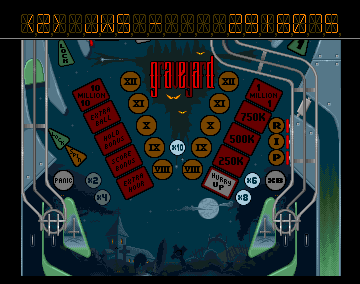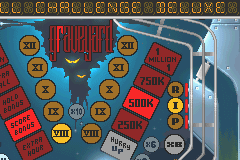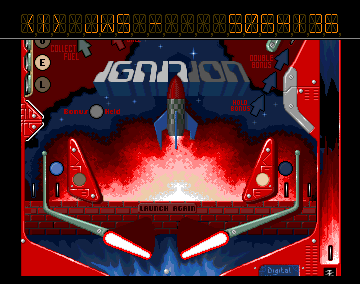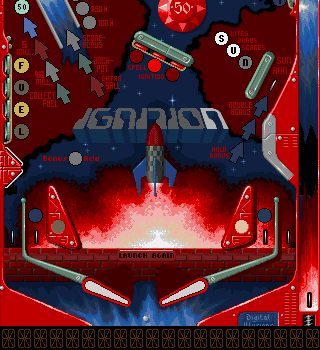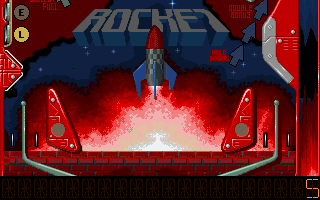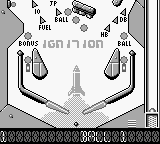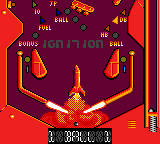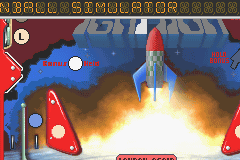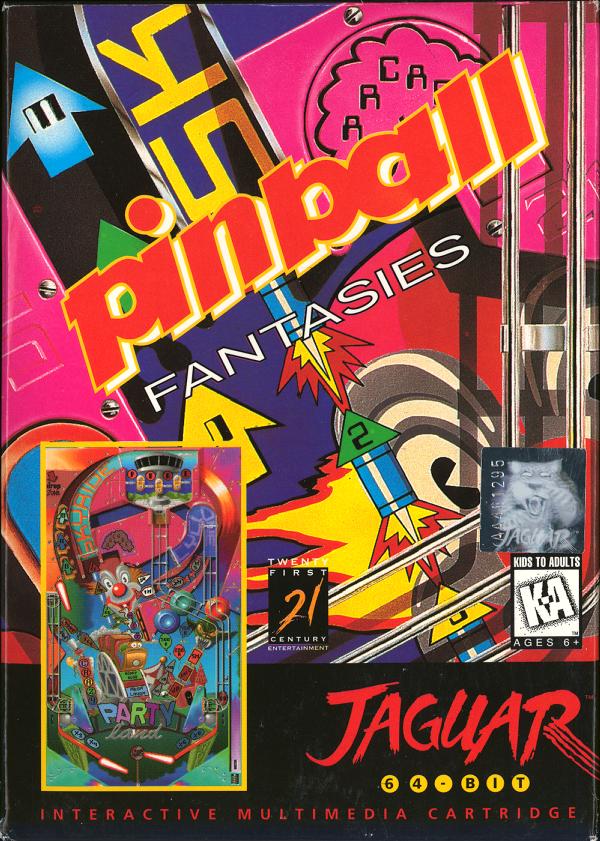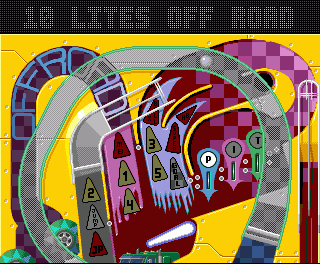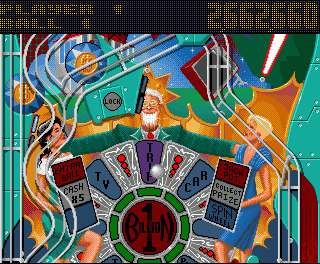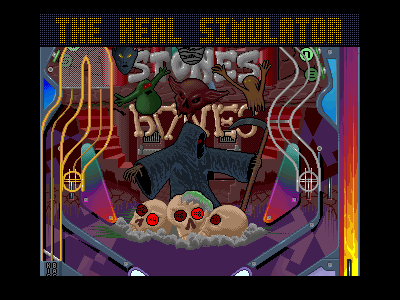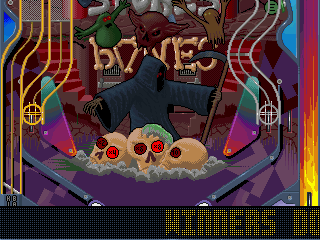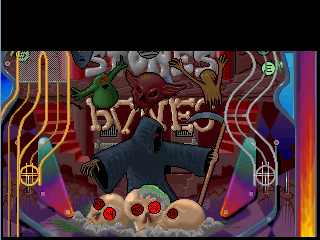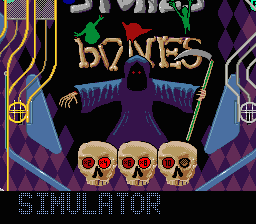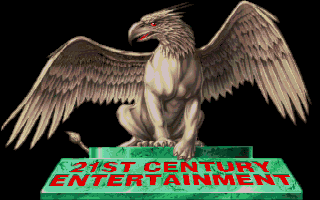
21st Century Pinball
|
<<< Prior Page |
|
Page 1: |
Page 2: |
Page 3: |
Page 4: |
Page 5: |
|
Page 6: |
Page 7: |
Page 8: |
It's the early nineties, and a demoscene group called The Silents has a pinball game up their sleeve. They've shopped it around to a few publishers, Bitmap Brothers among them, but the general consensus is that pinball games don't sell enough to make it worth publishing their game.
A fledgling company called 21st Century Entertainment, Inc., then known for publishing Amiga action titles like Rubicon and Deliverance, steps in and publishes the pinball title. I would imagine Bitmap Brothers was envious of the results, if not furious. That little pinball game was none other than Pinball Dreams, which not only sold millions worldwide, but also ended up being packed in with many Commodore Amiga computers and ported to many other platforms.
The demoscene group, now formed into a company called Digital Illusions CE (to later become more famous for their Battlefield series for Electronic Arts), put 21st Century on the map. After they finished their last pinball title, 21st passed the pinball duties off to another company, Spidersoft. More and more pinballs were released, many memorable tables were brought forth, and a great lifetime was had before 21st Century finally went kaput around 1999 - a whole two years before their namesake.
21st had four companies working for them throughout their existence. DICE, as mentioned above, worked on three major titles that are widely considered the best ones released. Spidersoft was brought in later to aid in porting the DICE games and was also eventually given the task of making original titles after DICE moved on. Unique Development was picked up for the purposes of remaking Obsession Pinball, and Liquid Dezign - comprised mainly of ex-DICE and UDS staff - was responsible for SlamTilt. In addition to this, 21st Century had an American publishing arm, confusingly named 21st Century Entertainment, Ltd. (as opposed to Inc.) - reputedly, neither branch was aware of what the other was doing. The US branch did no development of its own and existed solely to publish pinball games, and beyond that, would exclusively handle US publishing for games developed by the European branch. They continued existing at least a year after the European branch died.
DICE's first pinball title began when their lead artist started drawing pinball tables in Deluxe Paint on his Amiga. The idea was, a better pinball simulator could be made by making the table several screens tall and simply scrolling up and down the table, as opposed to earlier Amiga pinball games which simply showed the entire table at once, or NES Pinball which would cut between screens without even scrolling. None of the original tables ever saw the light of day, but the concept lived on, and four tables came from DICE to form Pinball Dreams. The Silents didn't originally intend for Pinball Dreams to be a commercial title, but once 21st Century came into the picture, things quickly changed.
Pinball Dreams plays from an overhead perspective, with the table view scrolling to follow the ball. The perspective may not be realistic (like, say, KAZe's Super Pinball series for SNES), but this way, DICE was able to put more processing into the ball physics. A wise decision: the ball physics in Pinball Dreams are stellar, to say the least - most tricks employed by real pinball experts will actually work here, including holding the ball with the flippers, juggling, and ricocheting off the side bumpers to make those tricky shots. Each table is lovingly crafted, well painted, and has plenty of features and opportunities to make skillful scores.
Ignition
A space-themed table that features a skill shot, bonus hold, and easy opportunities to increase your score multiplier. Fuel your ship and try to make it to Mars... and beyond! The music in this one is appropriately sci-fi-heroic, and the table's red color scheme really works well here. I actually find this one the hardest to get a good score on, because while it's easy to boost your multiplier and get bonus holds, actually getting the points to make them worth it involves some tricky upper-table shots (spell FUEL on the left and then hit the upper-left ramp) and spelling IGNITION with the center drop targets. The skill shot on this table, though, is probably the second-easiest (next to Steel Wheel) if you're handy with the nudge button. That's an easy 2x, right from the start of the ball.
Steel Wheel
The easiest table of the bunch, Steel Wheel is themed after the Old West. Points are very easy to pick up in this one, especially if you get the skill shots and all the add-on cars for your train (which result in all kinds of bonuses for you down the line). Great banjo music and a nice brown and grey color scheme round this table out. Hitting the ramps repeatedly will eventually start giving you massive points, especially if you hit them several times in quick succession. The skill shot is probably the easiest in the game, since there are only three possible lanes for the ball to roll into at first, and there's enough surface for the ball to roll on that if you're going down the wrong lane, a simple nudge will send it into a different one. Of course, excessive nudging does lead to a tilt, but Pinball Dreams is surprisingly lenient about that...
Interestingly, the layout and gameplay of Steel Wheel was more or less based on Williams' Bad Cats table from 1989. For the MS-DOS port, the facing direction of one of the ramps was swapped to make this connection a bit less noticeable - this change didn't stick for the other ports.
Beat Box
Probably my least favorite of the bunch. Beat Box is themed after the rap/hip-hop music industry, with a primary-colors scheme that makes it stand out. Gameplay, in my opinion, is rather weak, and the multi-level structure at the top tends to make it confusing where your ball is actually going. The music is nice, I suppose, but I just can't get used to this table, on account of not knowing how to get a good score on it. The game doesn't really make it that easy to figure out, considering half of the ramps are unlabeled and only make sound effects as you roll through them under normal circumstances (as opposed to displaying prompts on the scoreboard). Some of the ramps don't even give you points at all, unless you've set up the combo for them first. To put things bluntly, you have to be pretty good at pinball in the first place if you want to do well on this table.
Nightmare
The hardest table here, appropriately enough. Nightmare takes place in a graveyard, and has a steeper slanted table than the other three, which means your ball is going to be much harder to launch up and easier to lose. On the flip side, though, skilled players can earn far more points on this table than the other three, due to its many opportunities for jackpots by hitting the ramps a lot. Nearly every ramp hit on this table will increase the jackpot. I love the music for this table. Strangely, the menu picture calls this table Nightmare, but only the word Graveyard appears on the table itself. This was fixed, however, for GameTek's handheld adaptations.
Interestingly, because of DICE's origins in the demoscene, many crack groups and pirates swore a pact to not crack or release Pinball Dreams through their respective services, out of respect for the developers. While the pact didn't last long (it was eventually released by Fairlight, though with the message "A GAME WORTH PLAYING IS A GAME WORTH BUYING!" on their cracktro screen), it's things like this that show that there is honor even among software pirates. To an extent, anyway. The boys at DICE probably weren't too happy, considering that they previously collaborated with Fairlight for an Assembly demo.
Pinball Dreams got a few good ports, with versions for DOS, the Super Nintendo, Game Boy, and Game Gear. The DOS version is reasonably accurate to the Amiga original, even including the original MOD-based music tracks, as well as an alternative MIDI soundtrack for use with Roland MT-32. Sadly, as awesome as the idea is of Gustaffsen's music being remixed for what was at the time considered the best music device around, the MIDI conversions of the songs just don't quite have the same feel as their MOD versions, with wrong notes, misplaced instruments, and no regard for overall volume, causing horrible clipping unless you turn down the MT-32 itself. This port was actually released in three different versions - the original stand-alone release (and more common) only included the low-res 320x200 mode and required you to select your sound card every time the game was started, but was still a good conversion of the Amiga original. The second version was nearly identical except for the fact that it has a slightly different sound setup menu, lacking the Roland support but still offering Adlib as an option, and also the addition of the high-res 320x350 screen mode, which looks smushed on most screens unless the monitor is adjusted. This second port was bundled with Pinball Dreams 2 on a single CD-ROM and included a new options menu that lets you specify the number of balls per game (3, 5, or 7) and the tilt angle of the table (affects how fast the ball falls and how easy it is to make shots with the flippers). The ports both had a few other oddities in the ball physics such as occasionally getting the ball stuck on the side bumpers and triggering them rapidly. The PC ports were handled by Spidersoft, who would go on to make pinball games of their own.
The original MS-DOS port was later hacked apart by Expert Software, who were at that point becoming infamous for selling jewelcased CD-ROMs containing demo or shareware versions of commercial games. Pinball 2000 is one such product, as it is literally less than half of Pinball Dreams, as the Ignition and Nightmare tables were renamed to Rocket and Graveyard respectively, the Beat Box and Steel Wheel tables entirely cut out, and several elements of the remaining tables removed or simplified. Various notable omissions include the lack of extra ball features, some ramps being missing, and many bonus modes having been removed due to their triggering ramps no longer existing. It's really not worth the time or money.
The SNES port was handled by GameTek, evidently based on Spidersoft's DOS version. This port is quite surprising as hardly anything had to be cut (outside of the usual Nintendo censorship); even the music remains almost 100% intact (though a few samples were changed, and the intro tune is trimmed a bit). Some colors are changed for tables like Steel Wheel, and a few sounds were changed, but aside from that it's actually a very good port. About the only change Nintendo made to the game was on the Nightmare table, as there are some crosses in the table artwork that had their arms removed. As a strange note, the SNES port was published in Japan by Coconuts Japan and GX Media under the name Pinball Pinball. The game remains unchanged aside from the weird new name - 100% of the text remains in English. (I suppose LCD-segment displays don't handle kana very well.) There are a few minor bits in the table artwork that don't look quite as good due to conversion issues, but it still looks and plays pretty well.
There was also a Game Boy port from GameTek and Spidersoft, which is extremely bizarre. The Beat Box table was entirely cut (aside from its attract mode music, which is now used in the main menu), the Nightmare table was renamed to Graveyard (which is more consistent with what it says on the table), and given the Game Boy's lack of color and detail, much of the graphics had to be cut down and removed. The music especially suffers, with it not only having been essentially ripped to shreds to even work in the Game Boy, but tracks even seem to be switched around - a purist like me can't stand it when the attract song is played while your playing the table. The worst part is the ball physics: since the Game Boy doesn't really have a lot of processing power, the ball's movements have been vastly simplified, and it's very hard to get the flippers to nudge the ball lightly as opposed to catapulting it everywhere. That makes it kind of hard to pull off some of the trickier shots, or advanced tricks like juggling the ball between the flippers. This port is best avoided. There are far better Game Boy pinball titles out there.
Finally, Pinball Dreams received a Game Gear port, apparently based on the Game Boy port, and again handled by GameTek. This is essentially the Game Boy version with some color added to it, a few graphical touch-ups here and there, and slightly better music (though still oddly arranged). Beat Box is still missing. The weirdest change made to the game is that the point scale has been drastically reduced. What would have given you one million points in the original version will only get you 10,000 in the Game Gear port. Perhaps they ran out of screen space to contain the large scores? It puzzles me why they'd do that. It certainly takes the impact out of those massive jackpots, I must say.
The fans have not forgotten Pinball Dreams, however. A fan-made port to the GP32 exists, and C64 demoscene group Xenon is working on a Commodore 64 conversion of the game as well. It's not yet complete, as only Ignition and Nightmare are implemented and scoring doesn't work yet either, but it's impressive to see the game pulled off so well on a weaker system like this, and the ball physics are almost 100% intact as well (not to mention it's really kick-ass to hear Nightmare's song on the SID chip). Then, around 2002, UbiSoft and developer Binary9 acquired the rights to remake the Pinball Dreams and Pinball Fantasies tables for Game Boy Advance. That effort will be detailed later in the article.
Quick Info:
|
Developer: |
|
|
Publisher: |
|
|
Designer: |
|
|
Genre: |
Pinball Dreams (DOS)
Pinball Dreams (DOS)
Pinball Dreams (DOS)
Pinball Dreams (Amiga)
Pinball Dreams (Amiga)
Pinball Dreams (Game Boy Advance)
Comparison Screenshots
Pinball Fantasies / Pinball Fantasies Deluxe - Amiga, DOS, SNES, Atari Jaguar, Amiga CD32, Game Boy, PlayStation (1992)
DICE were really on to something with Pinball Dreams, so much so that they went ahead with a full-blown sequel, released around Christmas that same year. Four more tables, more imaginative than ever, with even more opportunities for scores. The engine has been improved upon, with new options that let you adjust the number of balls per game as well as the angle of the table (steeper angles make it harder to shoot or catch the ball), and each table is actually a whole screen larger than the tables of Pinball Dreams. Fantasies also adds in the Match system, where upon losing all your balls, the game will select a random number and compare it to the last digit of your score. If the two numbers match, you get one extra ball and another chance to redeem yourself. It essentially boils down to pure luck, but it's great for your score if you make it.
The game has four new tables with an even more interesting variety than Dreams. They're all brightly colored and well detailed, with very fitting music and plenty of awesome secrets. Most of the tables also have more than just the two flippers, with some flippers positioned on the upper levels as well for those trickier skill shots.
Partyland
The greatest theme park in the world. Launch the ball into duck targets, ride the Cyclone, find the secret passage, and generally just hit everything you can. A very upbeat song accompanies this table, but don't let the childish demeanor fool you: this is probably the hardest table in the game. There are tons of ball-traps that will give you points, but about half of them require you to set them up first - the snack bar hole on the left, for example, requires that you hit the three duck targets first. Partyland's skill shot is probably the trickiest, but I find it the most fun: rather than relying on how hard you launch the ball and your skill with the nudge button, the skill shot requires that you launch the ball all the way around the top end, and then send it into one of the ramps with the upper-level flipper. Given how fast the ball is going to be moving down the slope, it takes good timing to pull this off, but the reward is an easy million (and more if you can do it on every single ball).
Speed Devils
A high-speed race to the finish, with off-road sections and pit-stops. I really had a difficult time with this table. It seems to be designed pretty well, but I never managed to earn very many points on it - I'd actually say this almost edges out Partyland as the hardest table of any of DICE's games. While there isn't a skill shot on this table, it's fairly easy to get multiplier bonuses when you figure out the trick to it (it's all in the upper flipper) - hit all three PIT rollovers and then send the ball down the Off-Road ramp to get your multiplier up. The key to actually getting points, though, is to hit both sets of drop targets on the lower level, and hit the Mile ramps several times. These are pretty tricky shots to make, and more often than not I found myself just redirecting the ball toward the side drains.
Billion Dollar Gameshow
They ain't kidding when they say billion dollar. There is actually a bonus in this table that will give you one billion points (yes, that's billion, with a B). Thing is, though, it's very hard to set up: you have to get most of the other bonuses on the table in a single ball! Even without this bonus, Billion Dollar is probably the most generous scoring table of this bunch, making it a breeze to get points on the ten millions and above in a single ball. This is especially true if you're good at hitting the topmost ramp: a few times in quick succession will make for easy millions, and even if you fail to hit the ramp, the ball will usually head straight for the upper flipper, giving you a chance to hit the Skill ramp.
Stones 'n' Bones
The final table of Pinball Fantasies is another horror-themed table like Pinball Dreams' Nightmare table, but this one is a little bit more forgiving, difficulty wise. It also has some very nice skill shot opportunities, and a chance for an extra ball if you shoot the Scream ramp ten times. Plenty of good bonuses to be found as well. This is the only table in Pinball Fantasies that does not have an extra upper-level flipper, but it's also the only one that offers a Kickback feature (light the RIP letters on the vault track), which is an absolute godsend for players that tend to lose their ball down the side drains.
Pinball Fantasies also had its share of ports, and probably holds the title for the most ported pinball game ever, gracing not only the Amiga, but also (inhales) the PC, the Super Nintendo, the original Game Boy, the Atari Jaguar, the Amiga CD32, and the PlayStation (with later ports of varying "official" status for GBA, iOS, PSP, PS3, and the free pinball sims Visual Pinball and Future Pinball). The PC version is fairly accurate to the AGA Amiga version, but does all kinds of strange tricks with the video modes that cause the colors in the menu to look strange on more modern systems (or DOSBox). Reputedly, the original Amiga release was riddled with bugs due to 21st rushing the game for Christmas (which is reflected by music composer Olof Gustaffsen in the notes of one of the game's music files). Most of the bugs were fixed up for the other releases, including the AGA-enhanced 256 color version, which was released at about the same time as the CD32 version. The AGA version looks a hell of a lot nicer than the original, given the extra colors and effects. This version pretty much served as the basis for all the ports. It should be noted that the CD32 version is pretty much exactly the same as the AGA Amiga version; the CD32 pretty much is an Amiga, down to everything but the KickStart ROM (hell, you can supposedly even install Workbench on it and treat it like any other Amiga). The PC port was done by Frontline Design, who also handled the Illusions port.
The SNES port is once again handled by GameTek. The music once again made it over with few problems (though it tends to play a little fast in some emulators for some reason), but the tables have become less colorful (as it's actually based on the original ECS Amiga release) and chunkier in places to better fit the SNES's comparatively smaller screen and cartridge size. Stones & Bones particularly suffers from this, as well as most of the artwork in Party Land. Billion Dollar Game Show looks okay for the most part. Speed Devils was probably the best done, but it still doesn't look that great. It's a little disappointing, the quality of this port compared to that of Pinball Dreams...
Spidersoft was in charge of the port to Atari Jaguar, which was published jointly between 21st Century and another company called Computer West. I'm probably not exaggerating when I say that Pinball Fantasies is the Jaguar's best game. The tables were brought over with virtually no flaws, plenty of color (they took advantage of the Jaguar's ability to display lots of colors and smoothed out some of the dithering), and accurate music. It's almost the best port of the bunch. It's just a shame that it had to be on the Jaguar. This was actually the first version of the game that I ever played, and the first of any 21st Century games I'd ever seen. A good way to start, I gotta admit.
The PlayStation port, handled by VAP Inc, is the strangest: it was released only in Japan as Pinball Fantasies Deluxe - almost entirely in English aside from some menu prompts - but with virtually no additions worthy of the Deluxe name. There's a rendered intro movie that's pretty forgettable, the menu system has been totally redone (and the awesome title/selection music has been removed), but all four tables are 100% accurate to the Amiga AGA versions, with the original music intact. The strange part is, some voices (in English) have been added to announce the bonuses (short clips like "Let's start!" and "One million!"). It doesn't really detract from the experience, but it is a little jarring if you're not used to it. The ball physics appear to have been altered here, too, so the ball will move much more predictably. I don't see this as a particularly good thing: the physics now lack a degree of precision, to the point where the ball will move in the exact same way when launching it at full power, ricochet off of the same bumper, and hit the same trigger every single time. Finally, the "match" sequence when you get a Game Over is totally missing, so if you run out of balls, you'll never get a chance for an extra ball. Like the other versions, you can adjust settings like the number of balls per game and the angle of the table, but this totally disqualifies you from the high score table if you do so (I don't believe the other versions do this). Note that this Pinball Fantasies Deluxe is not to be confused with the version for PC, which contains both Pinball Fantasies and Spidersoft's later Pinball Mania.
Lastly, Pinball Fantasies also received a Game Boy port from GameTek. This one is utter trash: many features of the tables are completely removed, as are the artwork and pretty much anything else that made the tables unique. The tracks in Stones 'n' Bones, the multi-levelled structure of Speed Devils... all of them have been totally removed. In addition, the game has oodles of slowdown. About the only partially saving grace is the music: the title theme is done pretty well on the Game Boy sound chip. That's about it. And at least all four of the tables are present this time, but one would have to wonder if the game would have been improved if GameTek axed one of them in favor of improving the game speed and ball physics. Oddly, this port was also renamed to Pinball Deluxe in certain markets.
Quick Info:
|
Developer: |
|
|
Publisher: |
|
|
Designer: |
|
|
Genre: |
Pinball Fantasies (Amiga AGA)
Pinball Fantasies (Amiga AGA)
Pinball Fantasies (Amiga AGA)
Pinball Fantasies (Amiga AGA)
Pinball Fantasies (DOS)
Pinball Fantasies (Future Pinball)
Comparison Screenshots
|
<<< Prior Page |
|
Page 1: |
Page 2: |
Page 3: |
Page 4: |
Page 5: |
|
Page 6: |
Page 7: |
Page 8: |
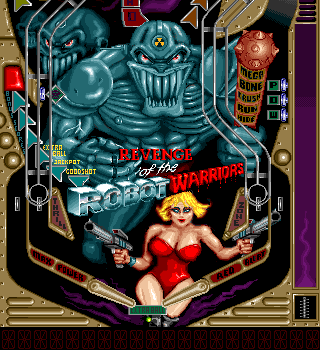
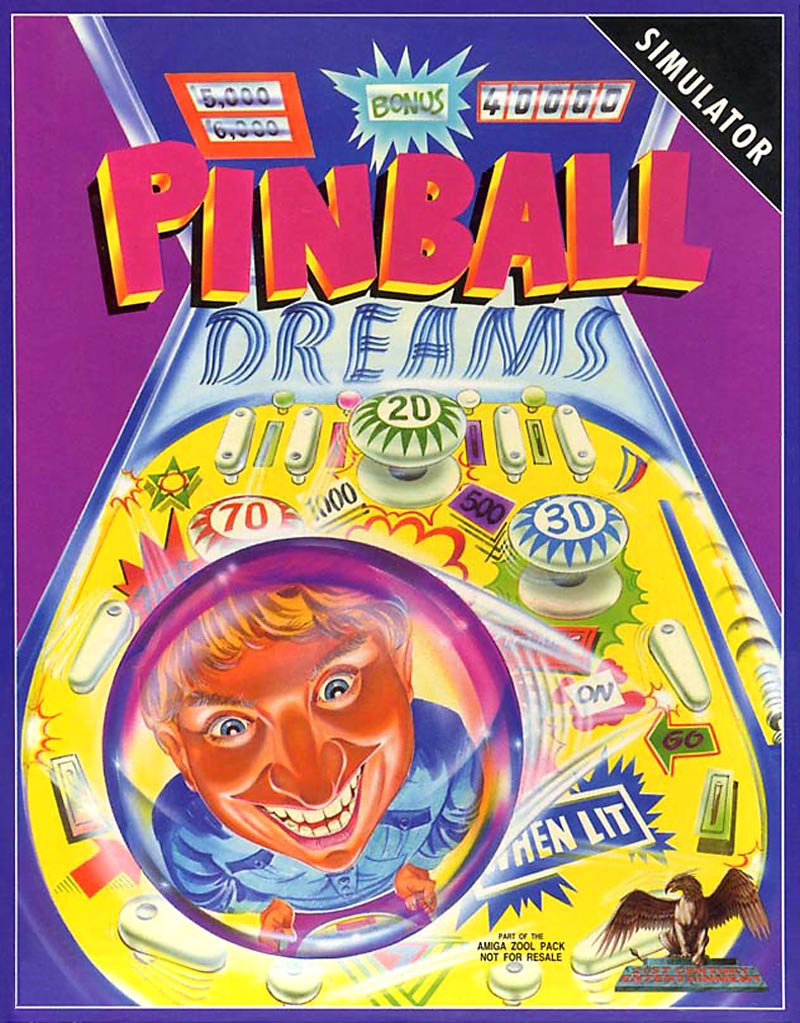

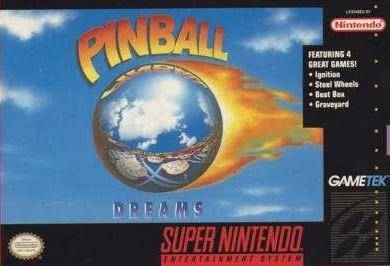
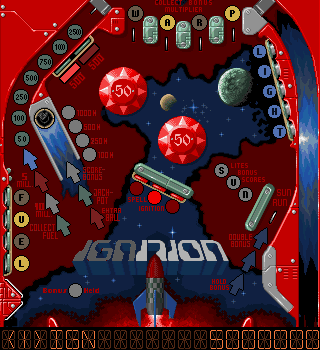
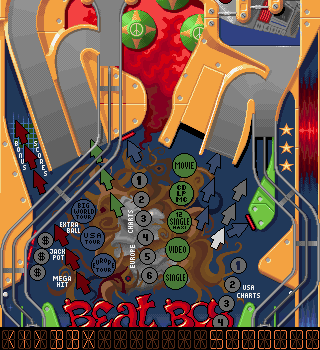
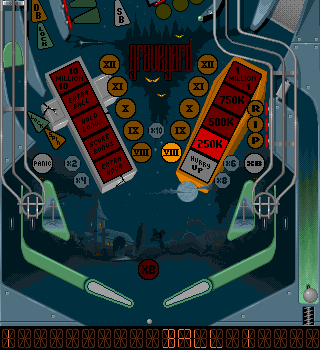
.png)
